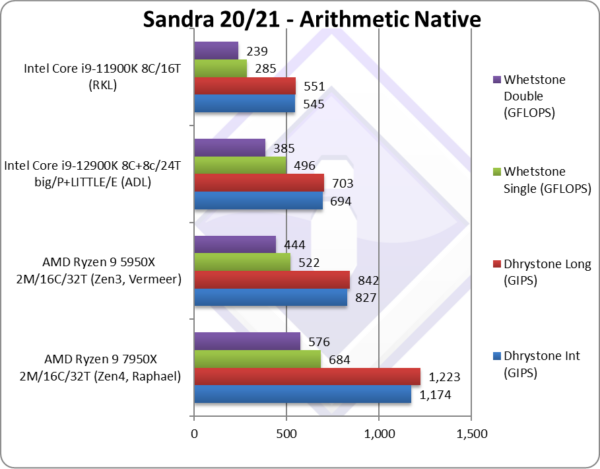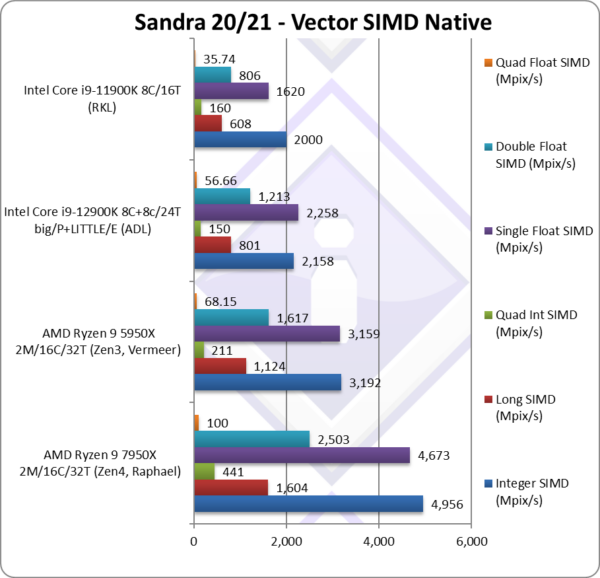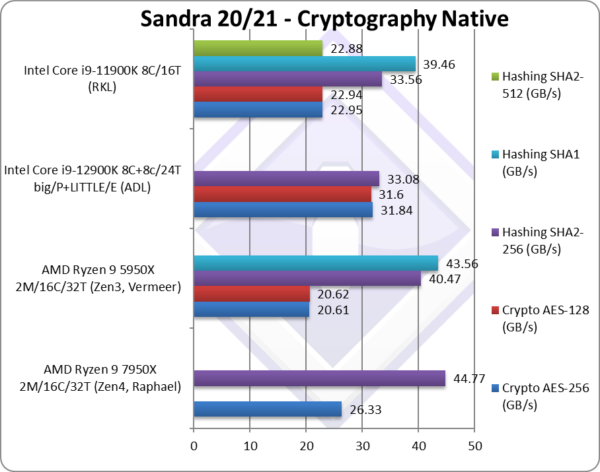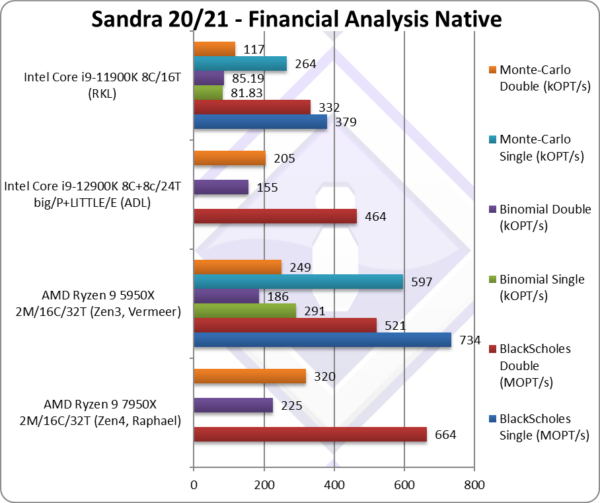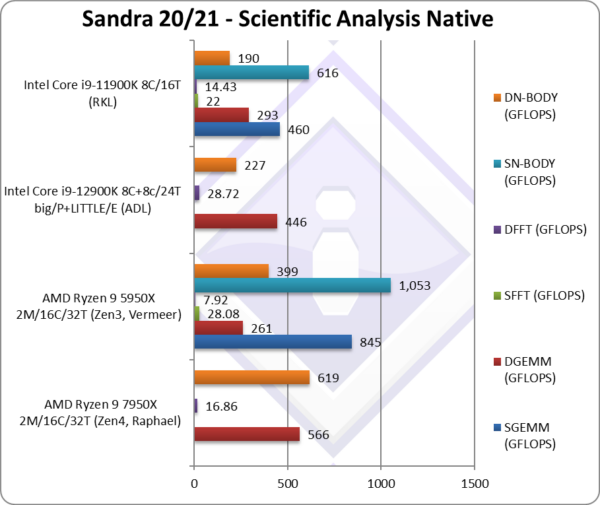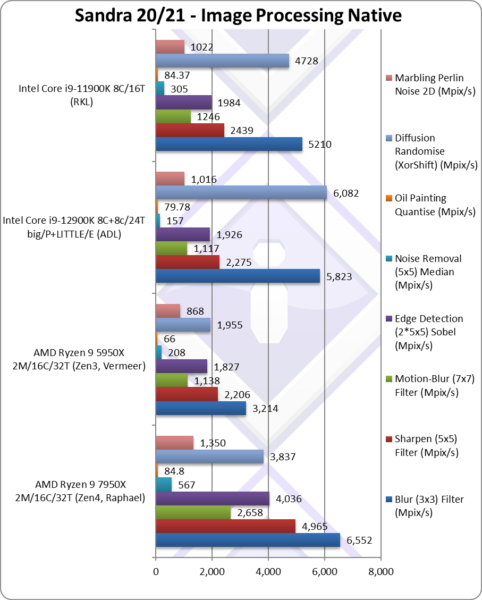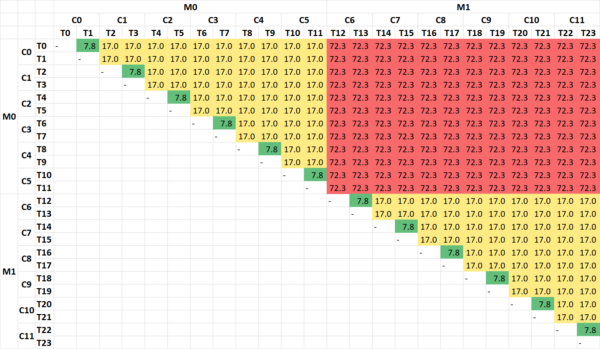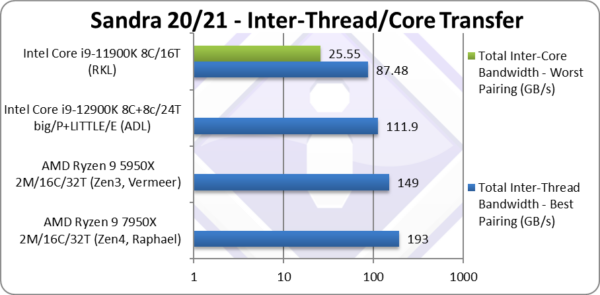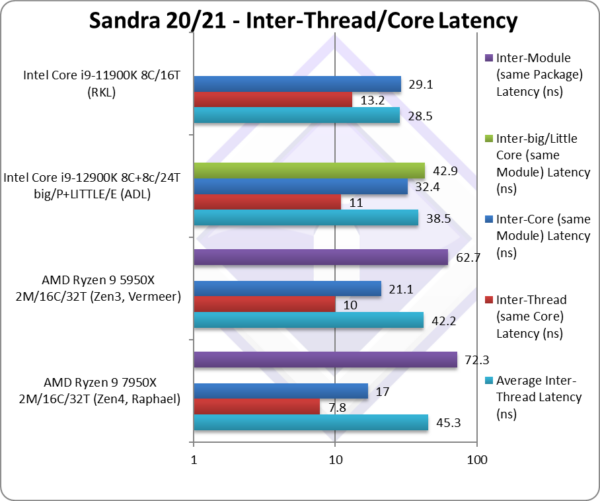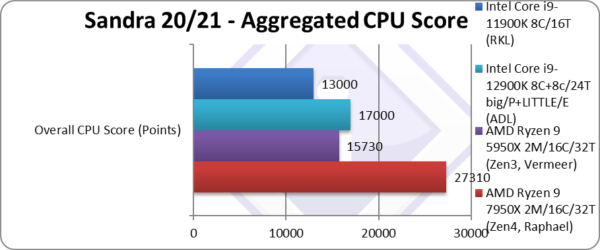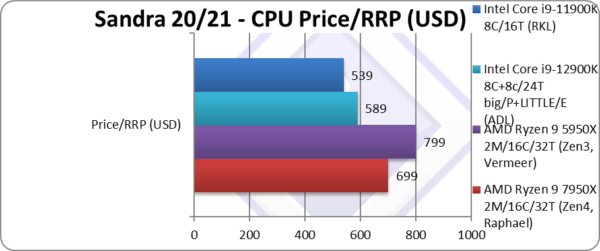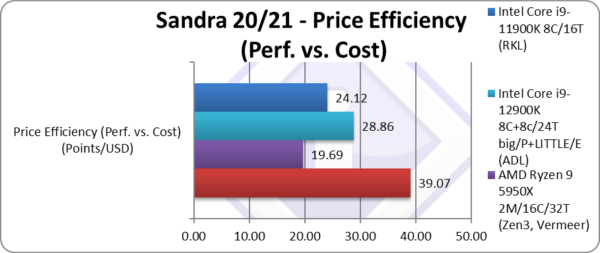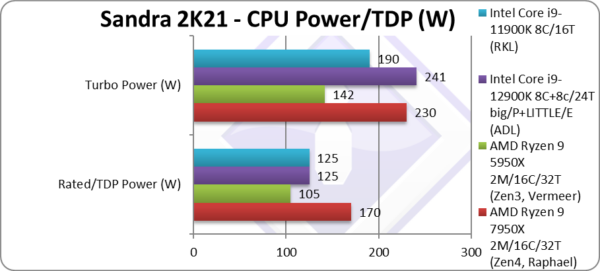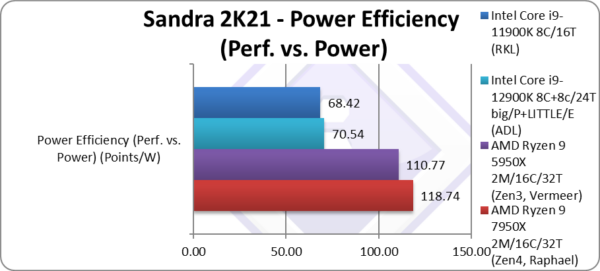What is “Zen4” (Ryzen 7000)?
AMD’s Zen4 (“Raphael”) is the 4rd generation ZEN core – aka the new 7000-series of CPUs from AMD – that brings brand new features like AVX512 ISA (instruction set support), DDR5 and PCIe5. These do require a brand new platform (AM5) almost a decade since the current AM4 platform was launched before even the 1st generation Ryzen. With any luck, it will remain for the next 4 or even more CPU generations, unlike the 2 generation support on competitor (Intel) platform.
Zen4 contains only big/P(erformance) cores and it is not a hybrid design. It remains to be seen if AMD will launch such hybrid (big/LITTLE) products that, in our opinion, are too problematic on desktop platforms for the benefits they bring. Even on mobile platforms where efficiency is a top priority – workloads do not easily lend to a hybrid design despite huge work done on the Windows scheduler for Windows 11. In this regard, a non-hybrid design like Zen4 is very much preferred.
AVX512 is a huge boost for compute performance as we’ve seen on Intel since SKL-X (Skylake-X). There is a reason it exists + all the extensions (IFMA, VNNI, VAES, etc.) and it is not unexpected that even basic usage can bring up to 100% (2x) performance improvement and even higher with specific instructions. While originally CPUs would reduce clocks due to the power generated – this has pretty much been mitigated in modern designs. Even Centaur (before Intel bought them) had AVX512-enabled (LITTLE) cores.
While here AMD has implemented it as 2x 256-bit ops (similar to previous AVX2/FMA3 in Zen1/1+/2 implemented as 2x 128-bit) – we still benefit from 2x more registers + 2x wider registers (4x overall), arguably better instruction specification, optimised extensions (IFMA, VNNI, VAES, etc.) that overall can still build up to a big improvement over old AVX2/FMA3.
- 5nm process (TSMC) for CCX (vs. 7nm on Zen3) for better efficiency and clocks
- 6nm process (TSMC) for I/O hub (vs. 12nm for Zen3) for better memory speeds
- claimed 13% IPC increase vs. Zen3 + clock increase uplift => ~29% total uplift vs. Zen 3
- AVX512 instruction support, with potential 100%+ improvement in optimised workloads
- Executed as 2x 256-bit (not true 512-bit like Intel) but still many benefits over AVX2/FMA3
- Specific AVX512 extensions (IFMA, VNNI, VAES, etc.) can bring well over 100% improvement
- DDR5 support up to 5200Mt/s (official) for much higher memory bandwidth vs. DDR4 Zen3
- Unofficial support for at least 6400Mt/s with XMP3/EXPO profiles
- AMD says 6000Mt/s is the “sweet-spot” for performance/value
- 1MB L2 per core (2x vs. 512kB on Zen3)
- L3 is the same at 32MB – other models will get V-Cache of 96MB
- PCIe5 support, up to 24 lanes (2x bandwidth vs. PCIe4)
- Still up to 2 chiplets (at launch) thus up to 2x 8C big/P cores (16C/32T on 7950X)
- Much higher both base and turbo speeds in most variants, e.g. 7950X
- Higher base 4.5GHz (vs. 3.4GHz on 5950X +32% clock uplift)
- Higher turbo 5.7GHz (vs. 4.9GHz on 5950X +17% clock uplift)
- TDP has been greatly increased to 170W (vs. 105W on 5950X) thus 60% higher! (ouch!)
- Turbo (PPT aka PL2) around 230W (vs. 142W on 5950X) thus 60% higher! (ouch!)
- Note that other models (e.g. 7700X) have kept the same TDP/Turbo
- Built-in Radeon Graphics (RDNA2) core
- 2CU / 128SP 400-2.2GHz cores for very basic graphics
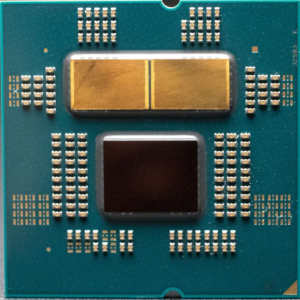
AMD Zen4 (Ryzen 7950X, 7900X) 2x Chiplets + I/O
Review
In this article we test CPU core performance; please see our other articles on:
- AMD Ryzen 7 7800X-3D (Zen4 V-Cache) Review & Benchmarks – VCache for the Win!
- AMD Ryzen 7 7700X (Zen4 Raphael) Review & Benchmarks – AVX512 Mainstream Performance
- AMD Ryzen 5 7600X (Zen4 Raphael) Review & Benchmarks – Value AVX512 Performance
- AMD Ryzen 7 5800X-3D (Zen3 V-Cache) Review & Benchmarks – CPU Performance
Hardware Specifications
We are comparing the top-range Ryzen 7 5000-series (Zen3 8-core) with previous generation Ryzen 7 3000-series (Zen2 8-core) and competing architectures with a view to upgrading to a top-range, high performance design.
| CPU Specifications | AMD Ryzen 9 7950X 16C/32T (Zen4, Raphael) | AMD Ryzen 9 5950X 16C/32T (Zen3, Vermeer) | Intel Core i9 12900K 8C+8c/24T (ADL, AlderLake) |
Intel Core i9 11900K 8C/16T (RKL, RocketLake) |
Comments | |
| Cores (CU) / Threads (SP) | 16C /32T | 16C / 32T | 8C+8c / 24T | 8C/16T | Core counts remain the same. | |
| Topology | 1 chiplet, 2 CCX, each 8 core (16C) + I/O hub | 1 chiplet, 2 CCX, each 8 core (16C) + I/O hub | Monolithic die | Monolithic die | Same topology | |
| Speed (Min / Max / Turbo) (GHz) |
4.5 [+32%] / 5.7GHz [+17%] |
3.4 / 4.9GHz | 3.9 + 2.4 / 5.2Ghz + 3.2Ghz | 3.5 / 5.3GHz | Base is 32% higher, turbo 16% | |
| Power (TDP / Turbo) (W) |
170 / 230W (PPT) [+61%] | 105 / 142W (PPT) | 125 / 241W (PL2) | 125 / 190W (PL2) | TDP is 60% higher but competitive | |
| L1D / L1I Caches (kB) |
16x 32kB 8-way / 16x 32kB 8-way | 16x 32kB 8-way / 16x 32kB 8-way | 8x 64kB + 8x 32kB / 8x 32kB + 8x 48kB | 8x 64kB + 8x 32kB | No changes to L1 | |
| L2 Caches (MB) |
16x 1MB (16MB) 8-way inclusive [+2x] | 16x 512kB (8MB) 8-way inclusive | 8x 1.25MB + 2x 2MB [14MB] | 8x 512MB [4MB] | L2 is 2x larger | |
| L3 Caches (MB) |
2x 32MB (64MB) 16-way exclusive |
2x 32MB (64MB) 16-way exclusive | 30MB 16-way | 16MB 16-way | L3 is the same | |
| Mitigations for Vulnerabilities | BTI/”Spectre”, SSB/”Spectre v4″ hardware | BTI/”Spectre”, SSB/”Spectre v4″ hardware | BTI/”Spectre”, SSB/”Spectre v4″ hardware | BTI/”Spectre”, SSB/”Spectre v4″ software/firmware | No new fixes required… yet! | |
| Microcode (MU) |
A60F12-03 | A20F10-09 | 090672-15 | 06A701-50 | The latest microcodes have been loaded. | |
| SIMD Units | 2x 256-bit (512-bit total) AVX512+ | 256-bit AVX/FMA3/AVX2 | 256-bit AVX/FMA3/AVX2 | 512-bit [1 Unit] AVX512+ | 2x wider SIMD | |
| Price/RRP (USD) |
$699 [-13%] |
$799 | $589 | $539 | Price is even 13% lower | |
Disclaimer
This is an independent review (critical appraisal) that has not been endorsed nor sponsored by any entity (e.g. AMD, etc.). All trademarks acknowledged and used for identification only under fair use.
The review contains only public information and not provided under NDA nor embargoed. At publication time, the products have not been directly tested by SiSoftware but submitted to the public Benchmark Ranker; thus the accuracy of the benchmark scores cannot be verified, however, they appear consistent and pass current validation checks.
And please, don’t forget small ISVs like ourselves in these very challenging times. Please buy a copy of Sandra if you find our software useful. Your custom means everything to us!
Native Performance
We are testing native arithmetic, SIMD and cryptography performance using the highest performing instruction sets. Zen4 supports all modern instruction sets including AVX2/FMA3 and crypto SHA HWA but also AVX-512 and extensions (IFMA, VNNI, VAES, etc.)
Results Interpretation: Higher values (GOPS, MB/s, etc.) mean better performance.
Environment: Windows 11 x64 (21H2), latest AMD and Intel drivers. 2MB “large pages” were enabled and in use. Turbo / Boost was enabled on all configurations. All mitigations for vulnerabilities (Meltdown, Spectre, L1TF, MDS, etc.) were enabled as per Windows default where applicable.
SiSoftware Official Ranker Scores
- AMD Ryzen 9 7950X 16-Core / 32-Thread
- AMD Ryzen 9 7900X 12-Core / 24-Thread
- AMD Ryzen 7 7700X 8-Core / 16-Thread
- AMD Ryzen 5 7600X 6-Core / 12-Thread
Final Thoughts / Conclusions
Summary: A powerhouse of a CPU (AMD Ryzen 7950X): 10/10!
Ever since Ryzen (Zen1) AMD has been hitting winners – with Zen2 (series 2000) and Zen3 (series 5000) bringing decent performance improvements – while still using the same AM4 platform (with BIOS updates). While some features (e.g. PCIe4, USB 3.2, etc.) may not be supported by old mainboards, you could still have gone from a 1st gen Ryzen to series 5000 16C/32T monster on the same platform; thus you’d be going to the very top of desktop performance beating anything the competition (Intel) had released on their latest platform.
AMD had to finally refresh the platform in order to bring new technologies support – DDR5 primarily, but also PCIe5, USB 4.0 – and they could have easily just stuck with that. But, no, AMD has instead brought a pretty revolutionary Zen4 – bringing AVX512 512-bit SIMD support just when Intel has dropped them in their latest hybrid designs (ADL, RPL).
However, both due to increased clocks and core improvements, even legacy code flies – all code is between 30% to 100% (2x) faster (7950X) than Zen3 (5950X) and thus also beats the Intel ADL competition (albeit with just 8 big/P Cores) into dust. The 8 LITTLE/E Atom cores are just not enough, ADL needs more big/P Cores to compete. Even with AVX512 implemented as 2x 256-bit, the new Zen4 instruction support provides sufficient performance improvement.
Price wise, if we’re talking the top end (7950X) this is 13% launch price cheaper – ending up 2x better value than the previous top-of-the-range (5950X) which is great value for money. Intel will have to reduce prices quite drastically to compete at least in the short term.
Our only negative is the greatly increased TDP (170W vs. 105W on Zen3 +60%) – although the turbo power (~240W PPT/PL2) is similar to Intel’s ADL (AlderLake) and likely (from rumours) still less than Intel’s future RPL (RaptorLake). Likely this is what allows Zen4 with 12-16C to perform much better vs. Zen3 that had the same TDP/PPT as the lower end models.
A new AM5 mainboard is required – but hopefully it will last you many more updates than the competition – possibly Zen7 (!) with 64C/128T (!) if things progress in the same manner we’ve seen until now. DDR5 memory has come down somewhat by now and brings much needed memory bandwidth improvements and USB 4.0 is very much needed for (very) high speed external devices. Not to mention PCIe5 support for future NVMe and GP-GPU components.
“Good things come to those who wait” it is said; in this case AMD has definitely delivered!
It did not have to be like this: if Intel had launched a 16-“big/P Core” AVX512-enabled ADL (AlderLake) – would be very competitive with Zen4; alas just 8 big Cores + 8 LITTLE Atom cores without AVX512 are not going to do it. With SIMD/AVX2 code 4 LITTLE/E Atom cores are just about faster than 1 big/P Core thus even 16 of them (as with RPL (RaptorLake)) won’t have enough compute performance to match Zen4 cores.
We will have to see how Intel responds to this – hopefully with more than just more LITTLE/E Atom cores. As consumers, we do need them to be competitive – otherwise we will see greatly increased prices even from the “underdog” as we have seen in the past.
Summary: A powerhouse of a CPU (AMD Ryzen 7950X): 10/10!
Please see the other reviews on the other Zen variants:
- AMD Ryzen 7 7800X-3D (Zen4 V-Cache) Review & Benchmarks – VCache for the Win!
- AMD Ryzen 7 7700X (Zen4 Raphael) Review & Benchmarks – AVX512 Mainstream Performance
- AMD Ryzen 5 7600X (Zen4 Raphael) Review & Benchmarks – Value AVX512 Performance
- AMD Ryzen 7 5800X-3D (Zen3 V-Cache) Review & Benchmarks – CPU Performance
Disclaimer
This is an independent review (critical appraisal) that has not been endorsed nor sponsored by any entity (e.g. AMD, etc.). All trademarks acknowledged and used for identification only under fair use.
The review contains only public information and not provided under NDA nor embargoed. At publication time, the products have not been directly tested by SiSoftware but submitted to the public Benchmark Ranker; thus the accuracy of the benchmark scores cannot be verified, however, they appear consistent and pass current validation checks.

